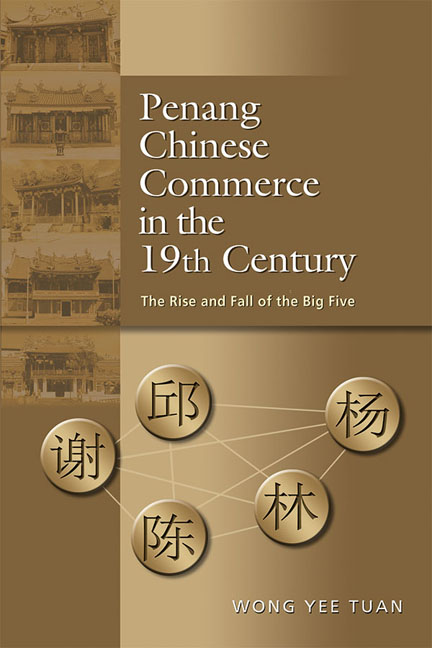Book contents
- Frontmatter
- Dedication
- Contents
- List of Tables, Diagrams and Maps
- Acknowledgements
- Glossary
- Abbreviations and Acronyms
- Notes on Spelling and Names
- Notes on Currencies
- Map
- 1 Introduction
- 2 Penang and the Big Five in Regional Context
- 3 Kith and Kin: The Big Five Familial Web
- 4 Opium Farm Rivalry
- 5 The Contest for ‘White Gold’
- 6 Western Mercantile Elite and Their Challenge to the Penang Chinese
- 7 New Regional Order and the Decline of the Big Five
- 8 Conclusion
- Appendices
- Bibliography
- Index
- About the Author
- Platesection
- Map
- Frontmatter
- Dedication
- Contents
- List of Tables, Diagrams and Maps
- Acknowledgements
- Glossary
- Abbreviations and Acronyms
- Notes on Spelling and Names
- Notes on Currencies
- Map
- 1 Introduction
- 2 Penang and the Big Five in Regional Context
- 3 Kith and Kin: The Big Five Familial Web
- 4 Opium Farm Rivalry
- 5 The Contest for ‘White Gold’
- 6 Western Mercantile Elite and Their Challenge to the Penang Chinese
- 7 New Regional Order and the Decline of the Big Five
- 8 Conclusion
- Appendices
- Bibliography
- Index
- About the Author
- Platesection
- Map
Summary
The Penang-centred region of the 1860s to the 1880s witnessed not only dynamic commercial and intensifying business competition. Opium revenue farming generated the most intense competition among the mercantile and political elite groups in the region. The Ghee Hin, a sworn brotherhood huicontrolled by the Cantonese, Teochew, Hakka (mainly Fui Chew) business elite, was the arch-rival of the Big Five. Besides, the Big Five also faced challenges from the Siamese local chiefs and British officials who attempted to break their monopolistic control of opium farms. This chapter investigates this competition. It begins by introducing the Cantonese, Teochew, and Hakka that clustered around the Ghee Hin before considering the challenges posed by the Ghee Hin, the Siamese, the British, and the Singapore Hokkien mercantile elite to the Big Five's opium and tin business. It then examines the strategies the Big Five adopted to deal with these challenges, showing how the Big Five weakened the challengers and achieved their opium farming hegemony in the region.
Sworn Brotherhood Hui: The Ghee Hin and Kian Teik To ng
The sworn brotherhood hui, more commonly known in Western sources as secret societies, were an inseparable element of the nineteenth-century Chinese society in the region. Carl Trocki has defined the sworn brotherhood huias organized agencies of social control and avenues of economic progress.1 As Francis Light wrote in January 1794 to the Governor-General of Bengal, the Chinese in Penang were a “valuable acquisition, but speaking a language which no other people understand, they are able to form parties and combinations in the most secret manner against any regulation of government” (Purcell 1948, p. 40). Light's statement indicated the existence of the sworn brotherhood hui, or the so-called secret societies in 1790s Penang. The Ghee Hin, founded in about 1790, was most probably the first and dominant huithere (Wong 1964/65, p. 120; Teoh 2002, p. 232). At the time it was jointly controlled by a group of influential Hokkien and Cantonese merchants.
In the early nineteenth century, however, as the Hokkien faction emerged as a dominant force in the business of revenue farming and played an active role in shipping and trading, the growing economic wealth of its main families enabled them to become more powerful in the hui.
- Type
- Chapter
- Information
- Penang Chinese Commerce in the 19th CenturyThe Rise and Fall of the Big Five, pp. 62 - 85Publisher: ISEAS–Yusof Ishak InstitutePrint publication year: 2015

